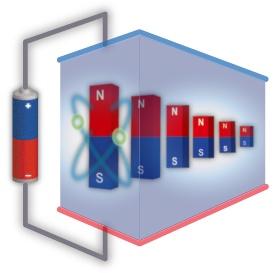

07/25/2011

The ability to switch the magnetic properties or electron ‘spin’ of a semiconductor in a similar way to charge in conventional devices opens up new possibilities for fast, low-power data storage and ‘spintronics’ applications. The magnetic semiconductor materials needed for such applications at room temperature, however, have proved elusive as most magnets are either metals or insulators. Now, researchers from the WPI-AIMR in collaboration with colleagues from the University of Tokyo have developed a magnetic semiconductor system with controllable ferromagnetism at room temperature1.
The compound studied — titanium dioxide containing a small amount of the magnetic element cobalt — has previously been suggested by some of the same researchers to be ferromagnetic at room temperature. “We have now unambiguously demonstrated not only that titanium cobalt dioxide is a ferromagnetic semiconductor, but also that it can be used for transistors using switchable ferromagnetism,” says Masashi Kawasaki from the research team.
The researchers achieved control of the magnetic properties of the material by modulating the density of electrons it contains: an accumulation of electrical charge enhances its magnetic properties, while the depletion of charge turns the magnetization off (see image). In previous studies, injecting sufficient charge into the material to drive this switching functionality had met with limited success because the voltages required were too high, destroying the sample.
To achieve high charge concentrations, the researchers used a recently developed approach that involves delivering electrical charge into the material using a liquid electrolyte rather than by the solid-state capacitor used previously. Such electrolytes are known to carry large quantities of charge, which has led to their use for electrical energy storage in applications such as supercapacitors in electrical cars. The use of a liquid electrolyte resulted in a system for which only a few volts were needed to switch the magnetism of titanium cobalt dioxide on and off.
The development of a magnetic semiconductor providing switchable magnetic properties at room temperature offers intriguing possibilities for high-performance devices that use not only the charge of an electron but also its ‘spin’ or magnetic properties. Although the use of a liquid electrolyte has its practical limitations and cannot, for example, be integrated easily on computer chips, Kawasaki is confident such hurdles can be overcome. “There are two possibilities. One is to search for a more practical way of switching, and the other to look for applications where liquids are suitable. The important point is that we know that switching can be achieved in the first place.”
Yamada, Y., Ueno, K., Fukumura, T., Yuan, H. T., Shimotani, H., Iwasa, Y., Gu, L., Tsukimoto, S., Ikuhara, Y. & Kawasaki, M. Electrically induced ferromagnetism at room temperature in cobalt-doped titanium dioxide. Science 332, 1065–1067 (2011). | article
This research highlight has been approved by the authors of the original article and all information and data contained within has been provided by said authors.